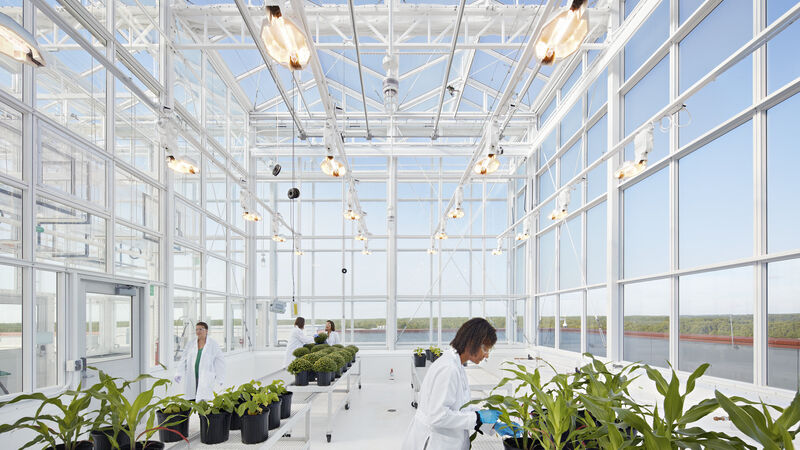
North Carolina State University
Plant Sciences Building
Flexible research space solving today's agricultural challenges.
A leading public research institution, North Carolina State University (NC State) offers high-quality education, builds strong communities, and discovers real-world solutions for complex challenges. Part of NC State is the North Carolina Plant Sciences Initiative (N.C. PSI), a groundbreaking program for advanced agricultural research and discovery.
As our global population continues to grow and climate changes, N.C. PSI drives plant science research forward, preparing for the future and strengthening the agricultural economy of North Carolina and beyond.
Centrally located in NC State’s Centennial campus, is the dynamic five-story, 185,000-square-foot Plant Sciences Building (PSB) for NC State’s College of Agriculture and Life Sciences (CALS) and N.C. PSI. This top-tier academic research facility cultivates strong academic, industry, government, and private-public partnerships. N.C. PSI teams pursue scientific knowledge benefiting all communities. PSB supports scientists cultivating innovative solutions to today’s challenges in plant research, agriculture, agribusiness, food production, sustainability, disease resistance, and climate change.
AEI provided mechanical, electrical, piping/plumbing, fire protection, technology, architectural lighting, security, and sustainable engineering design services to support the evolving academic and research facility requirements of PSB.
PSB manages thermal conductivity and weather exposure effectively through the exposed glass portions of the facility, utilizing external shading devices, fritted glazing, and high-performance clear glazing while maintaining visual clarity for facility occupants. For the facade, a terracotta and composite back-ventilated rainscreen cladding system alongside brick cavity wall assemblies accommodates the North Carolina climate, minimizing moisture penetration and reducing conductivity.

Building exterior
Ultimately achieving LEED Gold, AEI’s design for PSB incorporated:
- Active chilled beams
- Aircuity environmental monitoring system
- Automated lighting controls
- Bipolar needlepoint ionization
- DOAS units with three-legged coil setup
- Effluent decontamination systems
- Fully conditioned variable air volume research greenhouses
- Konvekta glycol run-around heat recovery loop
- Radiant ceilings (heating and cooling)
“This building is just the vehicle we needed to help us leverage all of North Carolina’s strengths and improve lives through innovations in food, health, and agricultural systems. Thanks to the Plant Sciences Building and a tremendous support network, and unbelievable talent, the N.C. PSI is going to deliver impactful solutions that will be leveraged within our state, throughout the nation, and even across the world.”
PSB supports interdisciplinary research in agricultural, engineering, biological, and data science fields. Within PSB’s five stories are numerous flexible spaces to fit diverse research needs and industry partnerships.
- 80,000 sf
- research lab space
Core Research Spaces
PSB's three core research spaces have state-of-the-art technology advancing scientific innovation.
- Cellular and Molecular Imaging Facility (CMIF)
- Genomics Sciences Laboratory (GSL)
- Molecular Education, Technology and Research Innovation Center (METRIC)
PSB is also equipped with a makerspace lab and think tank encouraging interdisciplinary agriculture research and collaboration.

Demonstration lab - A showcase space for sharing current research projects with the public and a flexible, hands-on learning and outreach environment.

The roof houses eleven highly customizable greenhouses for testing plant varieties before introducing them to outdoor environments.
NC PSB Rooftop Greenhouses
Meeting NC State’s request for flexibility, AEI designed each greenhouse compartment with variable airflow to efficiently accommodate various temperatures and temperature changes for diverse research requirements.
AEI added future secondary taps for chilled water to accommodate a smaller control valve for smaller loads. The greenhouse piping systems included fogging, plant watering, CO2 injection, and compressed air pesticide application systems. To support optimal plant growth, adjustable canopy lighting with LED and HID lights and vertical and horizontal shades were installed to control the sunlight.
Biosafety Level 3 (BSL-3) Research Facility
One of the eleven rooftop greenhouses, the 1,250-square-foot BSL-3 greenhouse research facility is equipped to study crop disease resistance and develop new disease-resistant plant varieties.
The BSL-3 research facility’s design includes an airlock, gowning and de-gowning area, and lab space. AEI designed the BSL-3 space with its dedicated air handling unit and HEPA filter, making it a recirculated greenhouse.

Each greenhouse has a dedicated air handling unit complete with ECM fans, chilled water, and hot water coils.

Large, floor-height fourth floor mechanical room feeding the rooftop greenhouses.
Directly beneath the greenhouses is an expansive mechanical room including air handling units placed beneath each greenhouse compartment. Acrylic return ductwork was installed in the greenhouse to maximize sunlight and reduce shadow.
Directly beneath the greenhouses is an expansive mechanical room including air handling units placed beneath each greenhouse compartment.
AEI optimized the full-floor mechanical room, ensuring convenient access for equipment servicing. The aspect ratio of the custom air handlers is intentionally set to be taller rather than wider for maintenance access. A sizeable mechanical space makes it easy to adapt these high-performing, functional research greenhouses for future use.
Driven to transform the agriculture and plant science industries through collaborative research and community outreach, NC State’s PSB is a state-of-the-art facility equipped with advanced technologies and flexible research space to solve today’s agricultural challenges and inspire innovation.

Learning commons